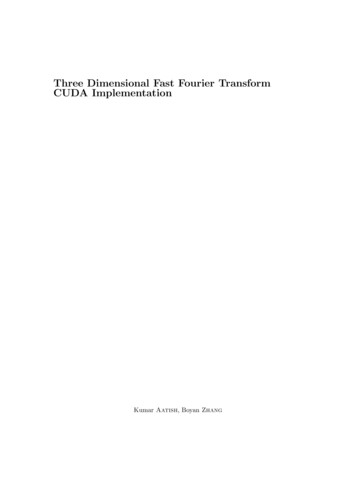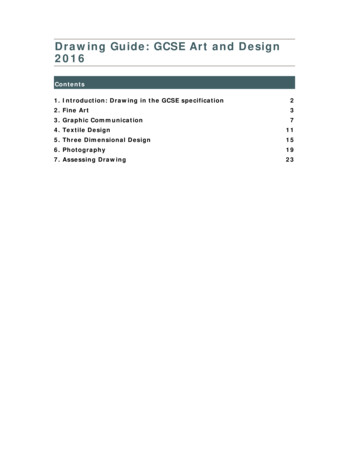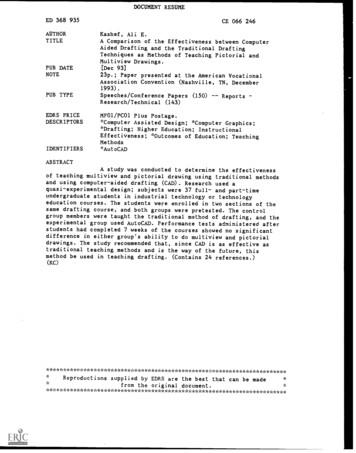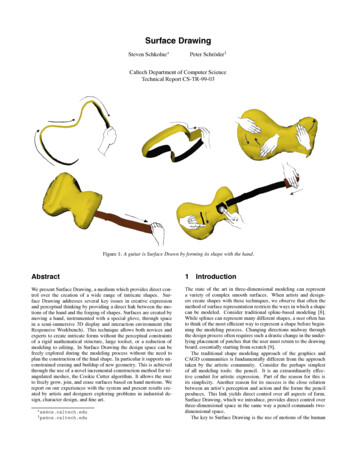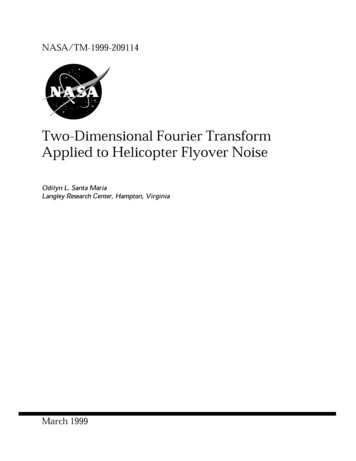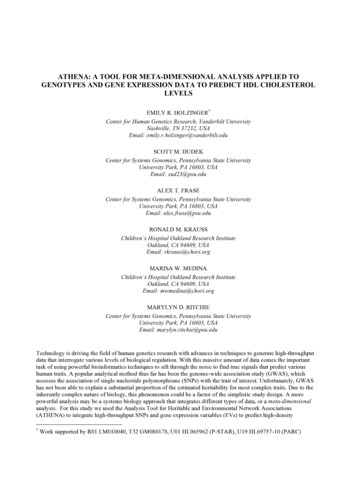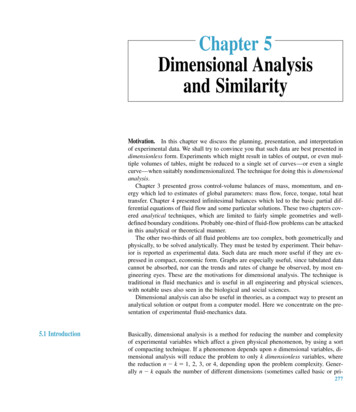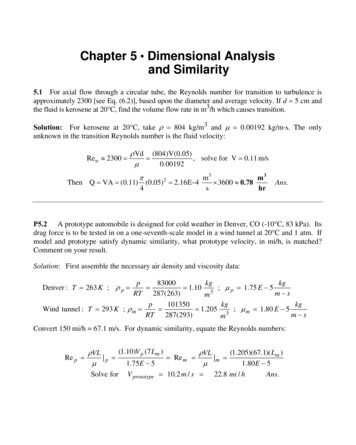
Transcription
Chapter 5 Dimensional Analysisand Similarity5.1 For axial flow through a circular tube, the Reynolds number for transition to turbulence isapproximately 2300 [see Eq. (6.2)], based upon the diameter and average velocity. If d 5 cm andthe fluid is kerosene at 20 C, find the volume flow rate in m3/h which causes transition.Solution: For kerosene at 20 C, take ρ 804 kg/m3 and μ 0.00192 kg/m s. The onlyunknown in the transition Reynolds number is the fluid velocity:Re tr 2300 ρ Vd (804)V(0.05) , solve for V 0.11 m/sμ0.00192Then Q VA (0.11)π4(0.05)2 2.16E 4m3m3 3600 0.78shrAns.P5.2 A prototype automobile is designed for cold weather in Denver, CO (-10 C, 83 kPa). Itsdrag force is to be tested in on a one-seventh-scale model in a wind tunnel at 20 C and 1 atm. Ifmodel and prototype satisfy dynamic similarity, what prototype velocity, in mi/h, is matched?Comment on your result.Solution: First assemble the necessary air density and viscosity data:p83000kgkg 1.10 3 ; μ p 1.75 E 5RT 287(263)m sm101350kgpkgWind tunnel : T 293 K ; ρ m 1.205 3 ; μ m 1.80 E 5RT 287(293)m smDenver : T 263 K ; ρ p Convert 150 mi/h 67.1 m/s. For dynamic similarity, equate the Reynolds numbers:Re p (1.10)V p (7 Lm )(1.205)(67.1)( Lm )ρVLρVL p Re m m μμ1.75E 51.80 E 5Solve forV prototype 10.2 m / s 22.8 mi / hAns.
Chapter 5 Dimensional Analysis and Similarity371This is too slow, hardly fast enough to turn into a driveway. Since the tunnel can go no faster,the model drag must be corrected for Reynolds number effects. Note that we did not need toknow the actual length of the prototype auto, only that it is 7 times larger than the model length.5.3 An airplane has a chord length L 1.2 m and flies at a Mach number of 0.7 in the standardatmosphere. If its Reynolds number, based on chord length, is 7E6, how high is it flying?Solution: This is harder than Prob. 5.2 above, for we have to search in the U.S. Stan-dardAtmosphere (Table A-6) to find the altitude with the right density and viscosityand speed of sound. We can make a first guess of T 230 K, a (kRT) 304 m/s, U 0.7a 213 m/s, and μ 1.51E 5 kg/m s. Then our first estimate for density isRe C 7E6 ρ UC ρ (213)(1.2), or ρ 0.44 kg/m 3 and Z 9500 m (Table A-6) μ1.51E 5Repeat and the process converges to ρ 0.41 kg/m3 or Z 10100 m Ans.5.4 When tested in water at 20 C flowing at 2 m/s, an 8-cm-diameter sphere has a measured dragof 5 N. What will be the velocity and drag force on a 1.5-m-diameter weather balloon moored insea-level standard air under dynamically similar conditions?Solution: For water at 20 C take ρ 998 kg/m3 and μ 0.001 kg/m s. For sea-level standardair take ρ 1.2255 kg/m3 and μ 1.78E 5 kg/m s. The balloon velocity follows from dynamicsimilarity, which requires identical Reynolds numbers:Re model ρVDμ model 998(2.0)(0.08) 1.6E5 Reproto 1.2255Vballoon (1.5)1.78E 50.001or Vballoon 1.55 m/s. Then the two spheres will have identical drag coefficients:C D,model FballoonF5N 0.196 CD,proto 2 222ρV D998(2.0) (0.08)1.2255(1.55)2 (1.5)2Solve for Fballoon 1.3 NAns.5.5 An automobile has a characteristic length and area of 8 ft and 60 ft2, respectively. Whentested in sea-level standard air, it has the following measured drag force versus speed:
Solutions Manual Fluid Mechanics, Fifth Edition372V, mi/h:Drag, lbf:20314011The same car travels in Colorado at 65 mi/h at an altitude of 3500 m. Using dimensional analysis,estimate (a) its drag force and (b) the horsepower required to overcome air drag.Solution: For sea-level air in BG units, take ρ 0.00238 slug/ft3 and μ 3.72E 7 slug/ft·s.Convert the raw drag and velocity data into dimensionless form:V (mi/hr):204060CD F/(ρV2L2):0.2370.2200.211ReL ρVL/μ:1.50E63.00E64.50E6Drag coefficient plots versus Reynolds number in a very smooth fashion and is well fit (to 1%)by the Power-law formula CD 1.07ReL 0.106.(a) The new velocity is V 65 mi/hr 95.3 ft/s, and for air at 3500-m Standard Altitude (Table A6) take ρ 0.001675 slug/ft3 and μ 3.50E 7 slug/ft s. Then compute the new Reynolds numberand use our Power-law above to estimate drag coefficient:ReColorado CD ρVL (0.001675)(95.3)(8.0) 3.65E 6, henceμ3.50 E 71.07 0.2157, F 0.2157(0.001675)(95.3)2 (8.0)2 210 lbf0.106(3.65E 6)Ans. (a)(b) The horsepower required to overcome drag isPower FV (210)(95.3) 20030 ft lbf/s 550 36.4 hpAns. (b)5.6 SAE 10 oil at 20 C flows past an 8-cm-diameter sphere. At flow velocities of 1, 2, and 3 m/s,the measured sphere drag forces are 1.5, 5.3, and 11.2 N, respectively. Estimate the drag force if thesame sphere is tested at a velocity of 15 m/s in glycerin at 20 C.Solution: For SAE 10 oil at 20 C, take ρ 870 kg/m3 and μ 0.104 kg/m s. Convert the rawdrag and velocity data into dimensionless form:V (m/s):F (newtons):CD F/(ρV2D2):ReL ρVD/μ:11.50.26966925.30.2381338311.20.2242008
Chapter 5 Dimensional Analysis and Similarity373Drag coefficient plots versus Reynolds number in a very smooth fashion and is well fit (to 1%)by the power-law formula CD 0.81ReL 0.17.The new velocity is V 15 m/s, and for glycerin at 20 C (Table A-3), take ρ 1260 kg/m3 and μ 1.49 kg/m s. Then compute the new Reynolds number and use our experimental correlation toestimate the drag coefficient:Re glycerin ρVD (1260)(15)(0.08) 1015 (within the range), henceμ1.49CD 0.81/(1015)0.17 0.250, or: Fglycerin 0.250(1260)(15)2 (0.08)2 453 NAns.5.7 A body is dropped on the moon (g 1.62 m/s2) with an initial velocity of 12 m/s.By using option 2 variables, Eq. (5.11), the ground impact occurs at t ** 0.34 and S ** 0.84.Estimate (a) the initial displacement, (b) the final displacement, and (c) the time of impact.Solution: (a) The initial displacement follows from the “option 2” formula, Eq. (5.12):(1.62)So11 0.34 (0.34)2S** gSo /Vo2 t** t**2 0.84 222(12)Solve for So 39 mAns. (a)(b, c) The final time and displacement follow from the given dimensionless results:S** gS/Vo2 0.84 (1.62)S/(12)2 , solve for Sfinal 75 m Ans. (b)t** gt/Vo 0.34 (1.62)t/(12), solve for t impact 2.52 sAns. (c)5.8 The Morton number Mo, used to correlate bubble-dynamics studies, is a dimensionlesscombination of acceleration of gravity g, viscosity μ, density ρ, and surface tension coefficientY. If Mo is proportional to g, find its form.Solution: The relevant dimensions are {g} {LT 2}, {μ} {ML 1T 1}, {ρ} {ML 3}, and{Y} {MT 2}. To have g in the numerator, we need the combination:abc L M M M {Mo} {g}{μ}a {ρ}b{Y}c 2 3 2 M 0 L0T 0 T LT L T Solve for a 4, b 1, c 3, or: Mo gμ 4ρY3Ans.
Solutions Manual Fluid Mechanics, Fifth Edition374P5.9The Richardson number, Ri, which correlates the production of turbulence by buoyancy,is a dimensionless combination of the acceleration of gravity g, the fluid temperature To, thelocal temperature gradient T/ z, and the local velocity gradient u/ z. Determine the form ofthe Richardson number if it is proportional to g.Solution: In the {MLTΘ} system, these variables have the dimensions {g} {L/T2}, {To} {Θ}, { T/ z} {Θ/L}, and { u/ z} {T-1}. The ratio g/( u/ z)2 will cancel time, leaving {L}in the numerator, and the ratio { T/ z}/To will cancel {Θ}, leaving {L} in the numerator.Multiply them together and we have the standard form of the dimensionless Richardson number: T)z Ri uTo ( ) 2 zg(Ans.5.10 Determine the dimension {MLTΘ} of the following quantities:(a) ρ u u 2T udx dy dz(b) ( p p0 ) dA (c) ρ c p(d) ρ x x y t12All quantities have their standard meanings; for example, ρ is density, etc.Solution: Note that { u/ x} {U/L}, { p dA} {pA}, etc. The results are: M ML M ML (a) 2 2 ; (b) 2 ; (c) 3 2 ; (d) 2 L T T L T T Ans.P5.11 During World War II, Sir Geoffrey Taylor, a British fluid dynamicist, used dimensionalanalysis to estimate the wave speed of an atomic bomb explosion. He assumed that the blastwave radius R was a function of energy released E, air density ρ, and time t. Use dimensionalanalysis to show how wave radius must vary with time.
Chapter 5 Dimensional Analysis and Similarity375Solution: The proposed function is R f(E, ρ, t). There are four variables (n 4) and threeprimary dimensions (MLT, or j 3), thus we expect n-j 4-3 1 pi group. List thedimensions:{R} {L} ; {E} {ML2 / T 2 } ; {ρ } {M/L3 } ; {t} {T}Assume arbitrary exponents and make the group dimensionless:R1 E a ρ b t c (L)1 (ML2 / T 2 ) a (M/L3 ) b (T) c M 0 L0 T 0 ,whence a b 0 ; 1 2a 3b 0 ; 2a c 0 ; Solve a 211; b ; c 555The single pi group isΠ1 R ρ 1/ 5E1/ 5 2 / 5t constant,thus Rwave t 2 / 5Ans.5.12 The Stokes number, St, used in particle-dynamics studies, is a dimensionless combination offive variables: acceleration of gravity g, viscosity μ, density ρ, particle velocity U, and particlediameter D. (a) If St is proportional to μ and inversely proportional to g, find its form. (b) Show thatSt is actually the quotient of two more traditional dimensionless groups.Solution: (a) The relevant dimensions are {g} {LT 2}, {μ} {ML 1T 1}, {ρ} {ML 3}, {U} {LT 1}, and {D} {L}. To have μ in the numerator and g in the denominator, we need thecombination:2 M T M L {St} {μ}{g} 1{ρ}a {U}b {D}c 3 a b {L}c M 0 L0T 0 LT L L T
376Solutions Manual Fluid Mechanics, Fifth EditionSolve for a 1, b 1, c 2, or: St This has the ratio form: St μUρ gD 2Ans. (a)U 2 /( gD )Froude number ρUD/μ Reynolds numberAns. (b)5.13 The speed of propagation C of a capillary wave in deep water is known to be a function onlyof density ρ, wavelength λ, and surface tension Y. Find the proper functional relationship,completing it with a dimensionless constant. For a given density and wavelength, how does thepropagation speed change if the surface tension is doubled?Solution: The “function” of ρ, λ, and Y must have velocity units. Thusa L M M {C} {f( ρ , λ ,Y)}, or C const ρ λ Y , or: 3 {L}b 2 T L T abccSolve for a b 1/2 and c 1/2, or: C constYρλAns.Thus, for constant ρ and λ, if Y is doubled, C increases as 2, or 41%. Ans.P5.14Consider flow in a pipe of diameter D through a pipe bend of radius R b. Thepressure loss Δp through the bend is a function of these two length scales, plus density ρ,viscosity μ, and average flow velocity V. (a) Use dimensional analysis to rewrite this function interms of dimensionless pi groups. (b) In analyzing data for such pipe-bend losses (Chap. 6), thedimensionless loss is often correlated with the Dean number, De:De Re DD2 RbCan your dimensional analysis produce a similar group? If not, explain why not.
Chapter 5 Dimensional Analysis and Similarity377Solution: (a) The proposed function is Δp f(ρ, μ, V, D, R b). There are six variables (n 6)and three primary dimensions (j 3), thus we expect n-j 6-3 3 pi groups. Selecting, forexample, (ρ, μ, V) as repeating variables, we would obtain the dimensionless functionΔpρV 2 ρVD D , fcn Rμb Ans.(a )(b) The Dean number combines the two pi’s on the right hand side, using fluid flow theory as aguide. This reduction from 3 to 2 pi groups cannot be predicted by pure dimensional analysis.5.15 The wall shear stress τw in a boundary layer is assumed to be a function of stream velocityU, boundary layer thickness δ, local turbulence velocity u′, density ρ, and local pressure gradientdp/dx. Using (ρ, U, δ ) as repeating variables, rewrite this relationship as a dimensionless function.Solution: The relevant dimensions are {τw} {ML 1T 2}, {U} {LT 1}, {δ} {L}, {u′} {LT 1}, {ρ} {ML 3}, and {dp/dx} {ML 2T 2}. With n 6 and j 3, we expect n j k 3pi groups: M L M Π1 ρ aU bδ cτ w 3 a b {L}c 2 M 0 L0T 0 , solve a 1, b 2, c 0 L T LT M L L Π 2 ρ aU bδ c u ′ 3 a b {L}c M 0 L0T 0 , solve a 0, b 1, c 0 L T T Π 3 ρ aU bδ cdp M a L b M 3 {L}c 2 2 M 0 L0T 0 , solve a 1, b 2, c 1dx L T L T The final dimensionless function then is given by:Π1 fcn(Π 2 , Π3 ), or: u′ dp δ τw fcn ,2 U dx ρU 2 ρUAns.5.16 Convection heat-transfer data are often reported as a heat-transfer coefficient h, defined byQ hAΔT
Solutions Manual Fluid Mechanics, Fifth Edition378where Q heat flow, J/sA surface area, m2ΔT temperature difference, KThe dimensionless form of h, called the Stanton number, is a combination of h, fluid density ρ,specific heat cp, and flow velocity V. Derive the Stanton number if it is proportional to h.2 {hAΔT}, then ML {h}{L2}{Θ}, or: {h} M If {Q}33 ΘT T cbd2 M M L L 1 b c dThen {Stanton No.} {h ρ cp V } 3 3 2 M0 L0 T0 Θ0 ΘT L T Θ T Solution:Solve forb 1, c 1, and d 1. 1Thus, finally, Stanton Number hρ 1cp V 1 hρ Vc pAns.5.17 The pressure drop per unit length Δp/L in a porous, rotating duct (Really! See Ref. 35)depends upon average velocity V, density ρ, viscosity μ, duct height h, wall injection velocity vw,and rotation rate Ω. Using (ρ,V,h) as repeating variables, rewrite this relationship in dimensionlessform.Solution: The relevant dimensions are {Δp/L} {ML 2T 2}, {V} {LT 1}, {ρ} {ML 3},{μ} {ML 1T 1}, {h} {L}, {vw} {LT 1}, and {Ω} {T 1}. With n 7 andj 3, we expect n j k 4 pi groups: They are found, as specified, using (ρ, V, h) as repeatingvariables:Π1 ρ aV b h cΠ2 ρ V h μab c 1Δp M a L b M 3 {L}c 2 2 M 0 L0T 0 , solve a 1, b 2, c 1L L T L T M L M 3 a b {L}c L T LT 1 M 0 L0T 0 , solve a 1, b 1, c 1 M L 1 Π 3 ρ aV b h c Ω 3 a b {L}c M 0 L0T 0 , solve a 0, b 1, c 1 L T T M L L Π 4 ρ aV b h c vw 3 a b {L}c M 0 L0T 0 , solve a 0, b 1, c 0 L T T The final dimensionless function then is given by:
Chapter 5 Dimensional Analysis and SimilarityΠ1 fcn(Π 2 , Π 3 , Π 4 ), or:379 ρVh Ωh vw Δp h,, fcn 2L ρVV V μAns.5.18 Under laminar conditions, the volume flow Q through a small triangular-section pore of sidelength b and length L is a function of viscosity μ, pressure drop per unit length Δp/L, and b. Usingthe pi theorem, rewrite this relation in dimensionless form. How does the volume flow change if thepore size b is doubled?Solution: Establish the variables and their dimensions: fcn(Δp/L ,Q{L3/T}μ, b ){M/L2T2} {M/LT} {L}Then n 4 and j 3, hence we expect n j 4 3 1 Pi group, found as follows:Π1 (Δp/L)a ( μ ) b (b)c Q1 {M/L2 T 2 }a {M/LT}b {L}c {L3 /T}1 M0 L0 T 0M: a b 0; L: 2a – b c 3 0; T: 2a – b – 1 0,solveΠ1 a 1, b 1, c 4Qμ constant( Δp/L)b4Ans.Clearly, if b is doubled, the flow rate Q increases by a factor of 16. Ans.5.19 The period of oscillation T of a water surface wave is assumed to be a function of density ρ,wavelength λ, depth h, gravity g, and surface tension Y. Rewrite this relationship in dimensionlessform. What results if Y is negligible?Solution: Establish the variables and their dimensions:T fcn({T}ρ, λ , h ,g ,Y){M/L3} {L} {L} {L/T2} {M/T2}Then n 6 and j 3, hence we expect n j 6 3 3 Pi groups, capable of various arrangementsand selected by myself as follows: h Y Typical final result: T(g/λ )1/2 fcn ,2 λ ρ gλ Ans.
380Solutions Manual Fluid Mechanics, Fifth Edition h If Y is negligible, ρ drops out also, leaving: T(g/λ )1/2 fcn λ Ans.5.20 We can extend Prob. 5.18 to the case of laminar duct flow of a non-newtonian fluid, forwhich the simplest relation for stress versus strain-rate is the power-law approximation: dθ dt τ C nThis is the analog of Eq. (1.23). The constant C takes the place of viscosity. If the exponent n is lessthan (greater than) unity, the material simulates a pseudoplastic (dilatant) fluid, as illustrated in Fig.1.7. (a) Using the {MLT} system, determine the dimensions of C. (b) The analog of Prob. 5.18 forPower-law laminar triangular-duct flow is Q fcn(C, Δp/L, b). Rewrite this function in the form ofdimensionless Pi groups.Solution: The shear stress and strain rate have the dimensions {τ} {ML 1T 2}, and {dθ/dt} {T 1}.(a) Using these in the equation enables us to find the dimensions of C:n M 1 M 2 {C} , hence {C } 2 n LT T LT Ans. (a)Now that we know {C}, combine it with {Q} {L3T 1}, {Δp/L} {ML 2T 2}, and{b} {L}. Note that there are 4 variables and j 3 {MLT}, hence we expect 4 3 only one pigroup: L3 M Δp M {Q}a b {L}c {C} a 2 2 b {L}c 2 n M 0 L0T 0 , L LT T L T solve a n, b 1, c 3n 1The one and only dimensionless pi group is thus:Q nCΠ1 constant( Δ p/ L ) b3 n 1Ans. (b)5.21 In Example 5.1 we used the pi theorem to develop Eq. (5.2) from Eq. (5.1). Instead ofmerely listing the primary dimensions of each variable, some workers list the powers of eachprimary dimension for each variable in an array:
Chapter 5 Dimensional Analysis and SimilarityFM 1L 1T 2381L U ρ μ0 01 1 1 1 3 1 0 1 0 1 This array of exponents is called the dimensional matrix for the given function. Show that the rankof this matrix (the size of the largest nonzero determinant) is equal to j n – k, the desired reductionbetween original variables and the pi groups. This is a general property of dimensional matrices, asnoted by Buckingham [29].Solution: The rank of a matrix is the size of the largest submatrix within which has a non-zerodeterminant. This means that the constants in that submatrix, when considered as coefficients ofalgebraic equations, are linearly independent. Thus we establish the number of independentparameters—adding one more forms a dimensionless group. For the example shown, the rank isthree (note the very first 3 3 determinant on the left has a non-zero determinant). Thus “j” 3for the drag force system of variables.5.22 The angular velocity Ω of a windmill is a function of windmill diameter D, wind velocity V,air density ρ, windmill height H as compared to atmospheric boundary layer height L, and thenumber of blades N: Ω fcn(D, V, ρ, H/L, N). Viscosity effects are negligible. Rewrite this functionin terms of dimensionless Pi groups.Solution: We have n 6 variables, j 3 dimensions (M, L, T), thus expect n j 3 Pi groups.Since only ρ has mass dimensions, it drops out. After some thought, we realize that H/L and Nare already dimensionless! The desired dimensionless function becomes:ΩD H fcn , N V L Ans.5.23 The period T of vibration of a beam is a function of its length L, area moment of inertia I,modulus of elasticity E, density ρ, and Poisson’s ratio σ. Rewrite this relation in dimensionlessform. What further reduction can we make if E and I can occur only in the product form EI?Solution: Establish the variables and their dimensions:T fcn( L , I ,{T}E,ρ,σ){L} {L4} {M/LT2} {M/L3} {none}Then n 6 and j 3, hence we expect n j 6 3 3 Pi groups, capable of various arrangementsand selected by myself as follows: [Note that σ must be a Pi group.]
Solutions Manual Fluid Mechanics, Fifth Edition382Typical final result: L4 T E fcn , σ Ans.L ρ I TL3If E and I can only appear together as EI, thenEIρ fcn(σ )Ans.5.24 The lift force F on a missile is a function of its length L, velocity V, diameter D, angle ofattack α, density ρ, viscosity μ, and speed of sound a of the air. Write out the dimensional matrix ofthis function and determine its rank. (See Prob. 5.21 for an explanation of this concept.) Rewrite thefunction in terms of pi groups.Solution: Establish the variables and their dimensions: fcn( L , V , D , α ,F{ML/T2}ρ,μ,a){L} {L/T} {L} {1} {M/L3} {M/LT} {L/T}Then n 8 and j 3, hence we expect n j 8 3 5 Pi groups. The matrix isM:L:T:The rank of this matrix is indeed three, hence there are exactly 5 Pi groups, as follows:Typical final result: Fρ VL L V fcn α ,,, 2 2D a μρV L Ans.P5.25The thrust F of a propeller is generally thought to be a function of its diameter D andangular velocity Ω, the forward speed V, and the density ρ and viscosity μ of the fluid. Rewritethis relationship as a dimensionless function.Solution: Write out the function with the various dimensions underneath:
Chapter 5 Dimensional Analysis and SimilarityF fcn({ML / T 2 }D ,{L}Ω{1 / T },Vρ,383{M / L3 }{L / T }μ,){M / LT }There are 6 variables and 3 primary dimensions (MLT), and we quickly see that j 3, because(ρ, V, D) cannot form a pi group among themselves. Use the pi theorem to find the three pi’s:Π1 ρ aV b D c F ; Solve for a 1, b 2, c 2. ThusΠ 2 ρ aV b D c Ω ; Solve for a 0 , b 1, c 1. ThusΠ 3 ρ aV b D c μ ; Solve for a 1, b 1, c 1.ThusΠ1 FρV 2 D 2Π2 Π3 ΩDVμρVDOne of many forms of the final desired dimensionless function isFρV 2 D 2 fcn(ΩDμ,)VρVDAns.5.26 A pendulum has an oscillation period T which is assumed to depend upon its length L,bob mass m, angle of swing θ, and the acceleration of gravity. A pendulum 1 m long, with a bobmass of 200 g, is tested on earth and found to have a period of 2.04 s when swinging at 20 . (a)What is its period when it swings at 45 ? A similarly constructed pendulum, with L 30 cm andm 100 g, is to swing on the moon (g 1.62 m/s2) at θ 20 . (b) What will be its period?Solution: First establish the variables and their dimensions so that we can do the numbers:T fcn( L , m ,{T}g, θ ){L} {M} {L/T2} {1}Then n 5 and j 3, hence we expect n j 5 3 2 Pi groups. They are unique:Tg fcn(θ ) (mass drops out for dimensional reasons)L(a) If we change the angle to 45 , this changes Π2, hence we lose dynamic similarity and do notknow the new period. More testing is required. Ans. (a)
Solutions Manual Fluid Mechanics, Fifth Edition384(b) If we swing the pendulum on the moon at the same 20 , we may use similarity:1/2 g T1 1 L1 1/2 9.81 m/s2 (2.04 s) 1.0 m or: T2 2.75 s1/2 1.62 m/s2 6.39 T2 ,0.3m Ans. (b)5.27 In studying sand transport by ocean waves, A. Shields in 1936 postulated that the bottomshear stress τ required to move particles depends upon gravity g, particle size d and density ρp, andwater density ρ and viscosity μ. Rewrite this in terms of dimensionless groups (which led to theShields Diagram in 1936).Solution: There are six variables (τ, g, d, ρp, ρ, μ) and three dimensions (M, L, T), hencewe expect n j 6 3 3 Pi groups. The author used (ρ, g, d) as repeating variables: ρ g1/2 d 3/2 ρp fcn , ρ gdμρ τAns.The shear parameter used by Shields himself was based on net weight: τ /[(ρp ρ)gd].5.28 A simply supported beam of diameter D, length L, and modulus of elasticity E is subjected toa fluid crossflow of velocity V, density ρ, and viscosity μ. Its center deflection δ is assumed to be afunction of all these variables. (a) Rewrite this proposed function in dimensionless form. (b) Supposeit is known that δ is independent of μ, inversely proportional to E, and dependent only upon ρV2, not ρand V separately. Simplify the dimensionless function accordingly.Solution: Establish the variables and their dimensions:δ fcn({L}ρ, D , L ,E,V ,μ){M/L3} {L} {L} {M/LT2} {L/T} {M/LT}Then n 7 and j 3, hence we expect n j 7 3 4 Pi groups, capable of various arrangementsand selected by myself, as follows (a):Well-posed final result: L ρ VD E , fcn ,Ans. (a)2 LDμVρ δ(b) If μ is unimportant, then the Reynolds number (ρVD/μ) drops out, and we have already cleverlycombined E with ρV2, which we can now slip out upside down:
Chapter 5 Dimensional Analysis and Similarity21δ ρV L , thenfcn ,ELE D δE L fcn Ans. (b)2ρV L D If μ drops out and δ or:3855.29 When fluid in a pipe is accelerated linearly from rest, it begins as laminar flow and thenundergoes transition to turbulence at a time ttr which depends upon the pipe diameter D, fluidacceleration a, density ρ, and viscosity μ. Arrange this into a dimensionless relation between ttr andD.Solution: Establish the variables and their dimensions:ρttr fcn({T}, D ,a,μ){M/L3} {L} {L/T2} {M/LT}Then n 5 and j 3, hence we expect n j 5 3 2 Pi groups, capable of various arrangementsand selected by myself, as required, to isolate ttr versus D: ρ a2t tr μ 1/3 ρ 2 a 1/3 μ2 fcn D Ans.5.30 The wall shear stress τw for flow in a narrow annular gap between a fixed and a rotatingcylinder is a function of density ρ, viscosity μ, angular velocity Ω, outer radius R, and gap width Δr.Using (ρ, Ω, R) as repeating variables, rewrite this relation in dimensionless form.Solution: The relevant dimensions are {τw} {ML 1T 2}, {ρ} {ML 3}, {μ} {ML 1T 1},{Ω} {T 1}, {R} {L}, and {Δr} {L}. With n 6 and j 3, we expect n j k 3 pigroups. They are found, as specified, using (ρ, Ω, R) as repeating variables: M 1 M Π1 ρ a Ω b R cτ w 3 a b {L}c 2 M 0 L0T 0 , solve a 1, b 2, c 2 L T LT Π2 ρ Ω R μabc 1 M 1 M 3 a b {L}c L T LT 1 M 0 L0T 0 , solve a 1, b 1, c 2 M 1 Π ρ a Ω b R c Δr 3 a b {L}c {L} M 0 L0T 0 , solve a 0, b 0, c 1 L T The final dimensionless function has the form:Π1 fcn(Π 2 , Π3 ), or: ρΩR2 Δr τ wallfcn μ , R ρΩ 2 R 2Ans.
Solutions Manual Fluid Mechanics, Fifth Edition3865.31 The heat-transfer rate per unit area q to a body from a fluid in natural or gravitationalconvection is a function of the temperature difference ΔT, gravity g, body length L, and three fluidproperties: kinematic viscosity ν, conductivity k, and thermal expansion coefficient β. Rewrite indimensionless form if it is known that g and β appear only as the product gβ.Solution: Establish the variables and their dimensions: fcn( ΔT ,q{M/T3}g, L , ν,β ,k){Θ} {L/T2} {L} {L2/T} {1/Θ} {ML/ΘT3}Then n 7 and j 4, hence we expect n j 7 4 3 Pi groups, capable of various arrangementsand selected by myself, as follows:If β and ΔT kept separate, then qLgL3 fcn βΔT, 2 kΔTν If, in fact, β and ΔT must appear together, then Π2 and Π3 above combine and we get βΔTgL3 qL fcn 2kΔ T ν Nusselt No.Grashof NumberAns.
Chapter 5 Dimensional Analysis and Similarity3875.32 A weir is an obstruction in a channel flowwhich can be calibrated to measure the flow rate,as in Fig. P5.32. The volume flow Q varies withgravity g, weir width b into the paper, andupstream water height H above the weir crest. If itis known that Q is proportional to b, use the pitheorem to find a unique functional relationshipQ(g, b, H).Fig. P5.32Solution: Establish the variables and their dimensions: fcn(Q{L3/T}g , b , H ){L/T2} {L} {L}Then n 4 and j 2, hence we expect n j 4 2 2 Pi groups, capable of various arrangementsand selected by myself, as follows:QQ b constant fcn ; but if Q b, then we reduce to5/21/2 3/2g Hbg H H 1/25.33 A spar buoy (see Prob. 2.113) has a periodT of vertical (heave) oscillation which dependsupon the waterline cross-sectional area A, buoymass m, and fluid specific weight γ. How doesthe period change due to doubling of (a) the massand (b) the area? Instrument buoys should havelong periods to avoid wave resonance. Sketch apossible long-period buoy design.Fig. P5.33Solution: Establish the variables and their dimensions:T{T} fcn( A , m ,γ){L2} {M} {M/L2T2}Then n 4 and j 3, hence we expect n j 4 3 1 single Pi group, as follows:TAγ dimensionless constantmAns.Ans.
Solutions Manual Fluid Mechanics, Fifth Edition388Since we can’t do anything about γ, the specific weight of water, we can increase period T byincreasing buoy mass m and decreasing waterline area A. See the illustrative long-period buoy inFigure P5.33.5.34 To good approximation, the thermal conductivity k of a gas (see Ref. 8 of Chap. 1) dependsonly on the density ρ, mean free path A, gas constant R, and absolute temperature T. For air at 20 Cand 1 atm, k 0.026 W/m K and A 6.5E 8 m. Use this information to determine k for hydrogen at20 C and 1 atm if A 1.2E 7 m.Solution: First establish the variables and their dimensions and then form a pi group: fcn(k{ML/ΘT3}ρ, A ,R,T ){M/L3} {L} {L2/T2Θ} {Θ}Thus n 5 and j 4, and we expect n j 5 4 1 single pi group, and the result isk /( ρ R 3/2T 1/2 A) a dimensionless constant Π1The value of Π1 is found from the air data, where ρ 1.205 kg/m3 and R 287 m2/s2 K:Π1,air 0.026 3.99 Π1,hydrogen(1.205)(287)3/2 (293)(6.5E 8)For hydrogen at 20 C and 1 atm, calculate ρ 0.0839 kg/m3 with R 4124 m2/s2 K. ThenΠ1 3.99 khydrogen(0.0839)(4124)3/2 (293)1/2 (1.2 E 7), solve for khydrogen 0.182WAns.m KThis is slightly larger than the accepted value for hydrogen of k 0.178 W/m K.5.35 The torque M required to turn the cone-plate viscometer in Fig. P5.35 depends upon theradius R, rotation rate Ω, fluid viscosity μ, and cone angle θ. Rewrite this relation in dimensionlessform. How does the relation simplify if it is known that M is proportional to θ ?Fig. P5.35
Chapter 5 Dimensional Analysis and Similarity389Solution: Establish the variables and their dimensions:M fcn( R , Ω , μ , θ ){ML2/T2}{L} {1/T} {M/LT} {1}Then n 5 and j 3, hence we expect n j 5 3 2 Pi groups, capable of only one reasonablearrangement, as follows:MM fcn(θ ); if M θ , then constant3μ ΩRμΩθ R 3Ans.See Prob. 1.56 of this Manual, for an analytical solution.5.36 The rate of heat loss, Qloss through a window is a function of the temperature differenceΔT, the surface area A, and the R resistance value of the window (in units of ft2 hr F/Btu): Qloss fcn(ΔT, A, R). (a) Rewrite in dimensionless form. (b) If the temperature difference
Chapter 5 Dimensional Analysis and Similarity 5.1 For axial flow through a circular tube, the Reynolds number for transition to turbulence is approximately 2300 [see Eq. (6.2)], based upon the diameter and average velocity. If d 5 cm and the fluid is kerosene at 20 C, find the volume flow rate in m3/h which causes transition. Solution: For kerosene at 20 C, take ρ 804 kg/m3 and μ .


